Topographic Effects on Titan’s Dune-Forming Winds
Abstract
:1. Introduction
2. Description of the Model
3. Results
3.1. Dune Location Analysis
3.2. GCM Simulations of the Near-Surface Winds
3.3. Resultant Drift Direction and Maximum Gross Bedform-Normal Transport
3.4. Statistical Analysis
3.5. Time Analysis of Surface Winds
4. Conclusions
Author Contributions
Funding
Acknowledgments
Conflicts of Interest
References
- Lorenz, R.D. The Sand Seas of Titan: Cassini RADAR Observations of Longitudinal Dunes. Science 2006, 312, 724–727. [Google Scholar] [CrossRef] [PubMed] [Green Version]
- Radebaugh, J.; Lorenz, R.D.; Lunine, J.I.; Wall, S.D.; Boubin, G.; Reffet, E.; Kirk, R.L.; Lopes, R.M.; Stofan, E.R.; Soderblom, L.; et al. Dunes on Titan observed by Cassini Radar. Icarus 2008, 194, 690–703. [Google Scholar] [CrossRef]
- Barnes, J.W.; Brown, R.H.; Soderblom, L.; Sotin, C.; Le Mouèlic, S.; Rodriguez, S.; Jaumann, R.; Beyer, R.A.; Buratti, B.J.; Pitman, K.; et al. Spectroscopy, morphometry, and photoclinometry of Titan’s dunefields from Cassini/VIMS. Icarus 2008, 195, 400–414. [Google Scholar] [CrossRef]
- Rubin, D.M.; Hesp, P.A. Multiple origins of linear dunes on Earth and Titan. Nat. Geosci. 2009, 2, 653–658. [Google Scholar] [CrossRef]
- Tokano, T. Dune-forming winds on Titan and the influence of topography. Icarus 2008, 194, 243–262. [Google Scholar] [CrossRef]
- Tokano, T. Relevance of fast westerlies at equinox for the eastward elongation of Titan’s dunes. Aeolian Res. 2010, 2, 113–127. [Google Scholar] [CrossRef]
- Radebaugh, J.; Lorenz, R.; Farr, T.; Paillou, P.; Savage, C.; Spencer, C. Linear dunes on Titan and earth: Initial remote sensing comparisons. Geomorphology 2010, 121, 122–132. [Google Scholar] [CrossRef]
- Rubin, D.M.; Ikeda, H. Flume experiments on the alignment of transverse, oblique, and longitudinal dunes in directionally varying flows. Sedimentology 1990, 37, 673–684. [Google Scholar] [CrossRef]
- Rubin, D.M.; Hunter, R.E. Bedform Alignment in Directionally Varying Flows. Science 1987, 237, 276–278. [Google Scholar] [CrossRef]
- Fenton, L.K.; Michaels, T.I.; Beyer, R.A. Inverse maximum gross bedform-normal transport 1: How to determine a dune-constructing wind regime using only imagery. Icarus 2014, 230, 5–14. [Google Scholar] [CrossRef]
- Friedson, A.J.; West, R.A.; Wilson, E.H.; Oyafuso, F.; Orton, G.S. A global climate model of Titan’s atmosphere and surface. Planet. Space Sci. 2009, 57, 1931–1949. [Google Scholar] [CrossRef]
- Larson, E.J.L.; Toon, O.B.; Friedson, A.J. Simulating Titan’s aerosols in a three dimensional general circulation model. Icarus 2014, 243, 400–419. [Google Scholar] [CrossRef]
- Lebonnois, S.; Burgalat, J.; Rannou, P.; Charnay, B. Titan global climate model: A new 3-dimensional version of the IPSL Titan GCM. Icarus 2012, 218, 707–722. [Google Scholar] [CrossRef]
- Newman, C.E.; Lee, C.; Lian, Y.; Richardson, M.I.; Toigo, A.D. Stratospheric superrotation in the TitanWRF model. Icarus 2011, 213, 636–654. [Google Scholar] [CrossRef]
- McDonald, G.D.; Hayes, A.G.; Ewing, R.C.; Lora, J.M.; Newman, C.E.; Tokano, T.; Lucas, A.; Soto, A.; Chen, G. Variations in Titan’s dune orientations as a result of orbital forcing. Icarus 2016, 270, 197–210. [Google Scholar] [CrossRef]
- Bagnold, R.A. The Physics of Blown Sand and Desert Dunes; Methuen: London, UK, 1941. [Google Scholar]
- Lorenz, R.D. Physics of saltation and sand transport on Titan: A brief review. Icarus 2014, 230, 162–167. [Google Scholar] [CrossRef]
- Ewing, R.C.; Hayes, A.G.; Lucas, A. Sand dune patterns on Titan controlled by long-term climate cycles. Nat. Geosci. 2015, 8, 15–19. [Google Scholar] [CrossRef]
- Charnay, B.; Barth, E.; Rafkin, S.; Narteau, C.; Lebonnois, S.; Rodriguez, S.; Courrech du Pont, S.; Lucas, A. Methane storms as a driver of Titan’s dune orientation. Nat. Geosci. 2015, 8, 362–366. [Google Scholar] [CrossRef]
- Lorenz, R.D.; Stiles, B.W.; Aharonson, O.; Lucas, A.; Hayes, A.G.; Kirk, R.L.; Zebker, H.A.; Turtle, E.P.; Neish, C.D.; Stofan, E.R.; et al. A global topographic map of Titan. Icarus 2013, 225, 367–377. [Google Scholar] [CrossRef] [Green Version]
- Corlies, P.; Hayes, A.G.; Birch, S.P.D.; Lorenz, R.; Stiles, B.W.; Kirk, R.; Poggiali, V.; Zebker, H.; Iess, L. Titan’s Topography and Shape at the End of the Cassini Mission: CORLIES ET AL: TITAN’S TOPOGRAPHY. Geophys. Res. Lett. 2017, 44, 11,754–11,761. [Google Scholar] [CrossRef]
- Lorenz, R.D.; Radebaugh, J. Global pattern of Titan’s dunes: Radar survey from the Cassini prime mission: PATTERN OF TITAN’S DUNES. Geophys. Res. Lett. 2009, 36. [Google Scholar] [CrossRef]
- Wilson, I.G. Ergs. Sediment. Geol. 1973, 10, 77–106. [Google Scholar] [CrossRef]
- Tanaka, K.; Rodriguez, J.; Skinnerjr, J.; Bourke, M.; Fortezzo, C.; Herkenhoff, K.; Kolb, E.; Okubo, C. North polar region of Mars: Advances in stratigraphy, structure, and erosional modification. Icarus 2008, 196, 318–358. [Google Scholar] [CrossRef]
- Le Gall, A.; Hayes, A.G.; Ewing, R.; Janssen, M.A.; Radebaugh, J.; Savage, C.; Encrenaz, P. Latitudinal and altitudinal controls of Titan’s dune field morphometry. Icarus 2012, 217, 231–242. [Google Scholar] [CrossRef]
- Neish, C.D.; Lorenz, R.D. Elevation distribution of Titan’s craters suggests extensive wetlands. Icarus 2014, 228, 27–34. [Google Scholar] [CrossRef]
- Kazeminejad, B.; Atkinson, D.H.; Pérez-Ayúcar, M.; Lebreton, J.-P.; Sollazzo, C. Huygens’ entry and descent through Titan’s atmosphere—Methodology and results of the trajectory reconstruction. Planet. Space Sci. 2007, 55, 1845–1876. [Google Scholar] [CrossRef]
- Karkoschka, E. Titan’s meridional wind profile and Huygens’ orientation and swing inferred from the geometry of DISR imaging. Icarus 2016, 270, 326–338. [Google Scholar] [CrossRef]
- Tokano, T. Near-surface winds at the Huygens site on Titan: Interpretation by means of a general circulation model. Planet. Space Sci. 2007, 55, 1990–2009. [Google Scholar] [CrossRef]
- Fryberger, S.G.; Ahlbrandt, T.S.; Andrews, S. Origin, sedimentary features, and significance of low-angle eolian “sand sheet” deposits, Great Sand Dunes National Monument and vicinity, Colorado. J. Sediment. Res. 1979, 49, 733–746. [Google Scholar] [CrossRef]
- Burr, D.M.; Bridges, N.T.; Marshall, J.R.; Smith, J.K.; White, B.R.; Emery, J.P. Higher-than-predicted saltation threshold wind speeds on Titan. Nature 2015, 517, 60–63. [Google Scholar] [CrossRef]
- Sullivan, R.; Kok, J.F. Aeolian saltation on Mars at low wind speeds: Low Speed Aeolian Saltation on Mars. J. Geophys. Res. Planets 2017, 122, 2111–2143. [Google Scholar] [CrossRef]
- Courrech du Pont, S.; Narteau, C.; Gao, X. Two modes for dune orientation. Geology 2014, 42, 743–746. [Google Scholar] [CrossRef] [Green Version]
- Tokano, T. Mountain torque and its influence on the atmospheric angular momentum on Titan. Icarus 2012, 220, 863–876. [Google Scholar] [CrossRef]
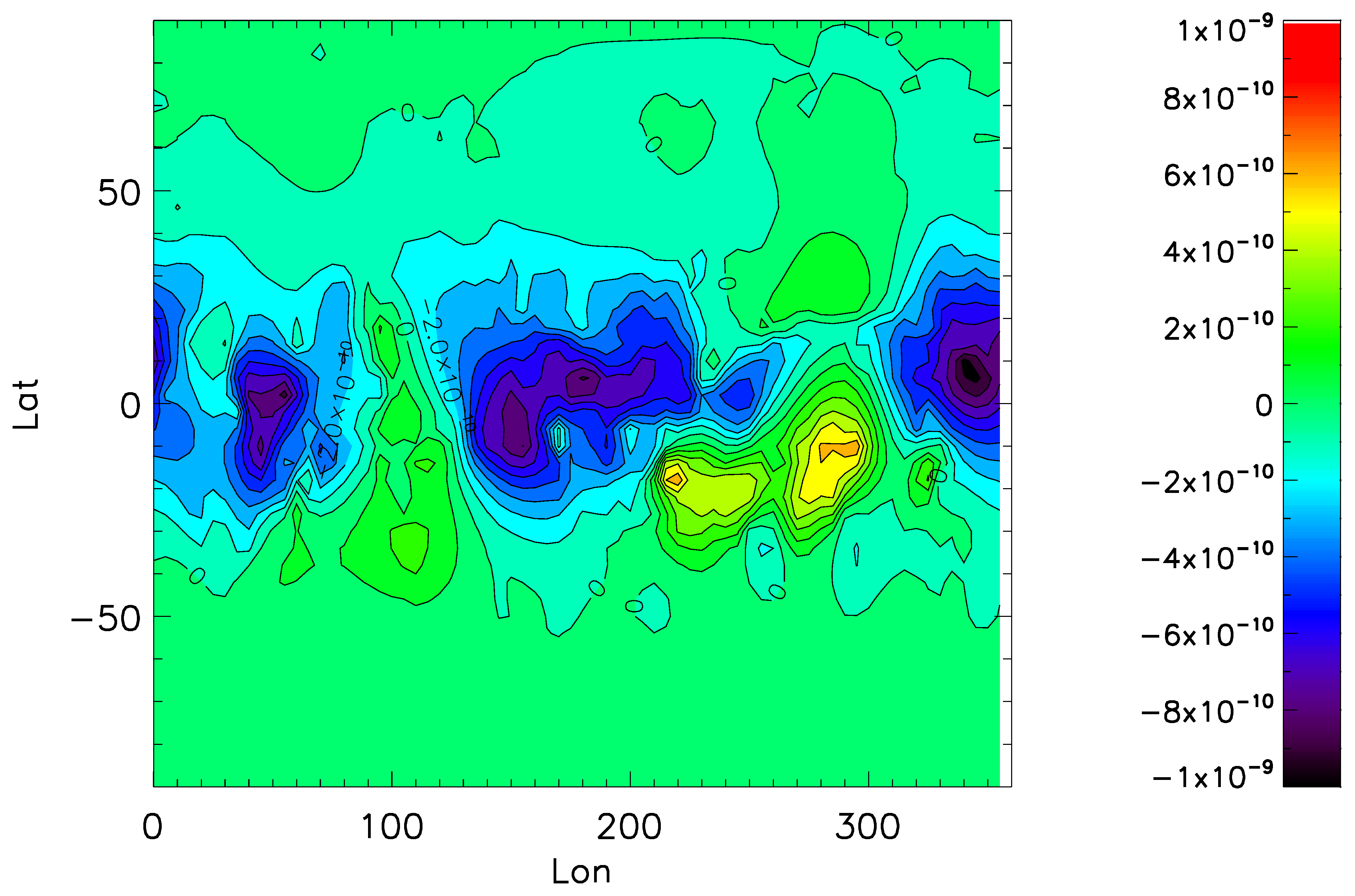
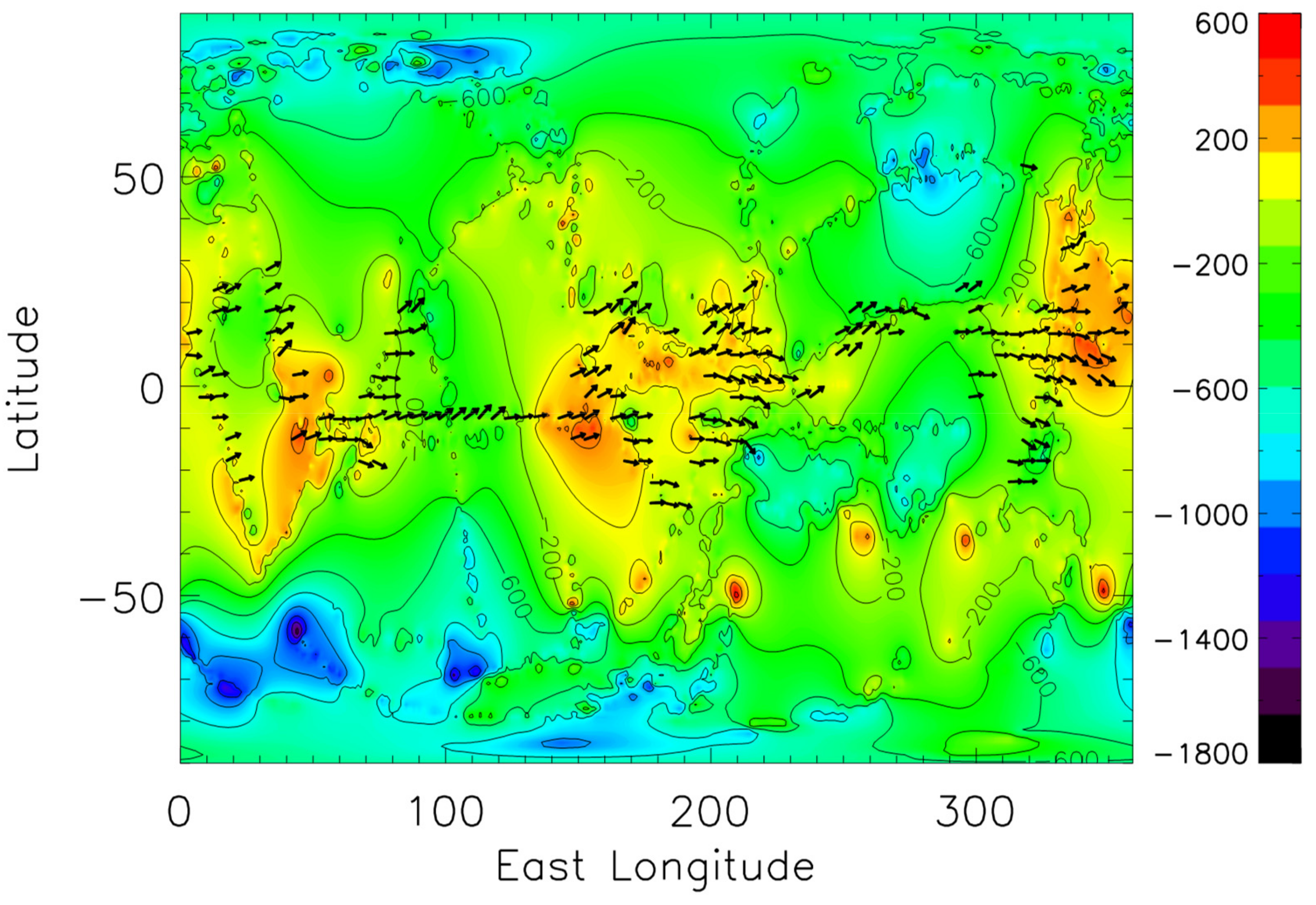
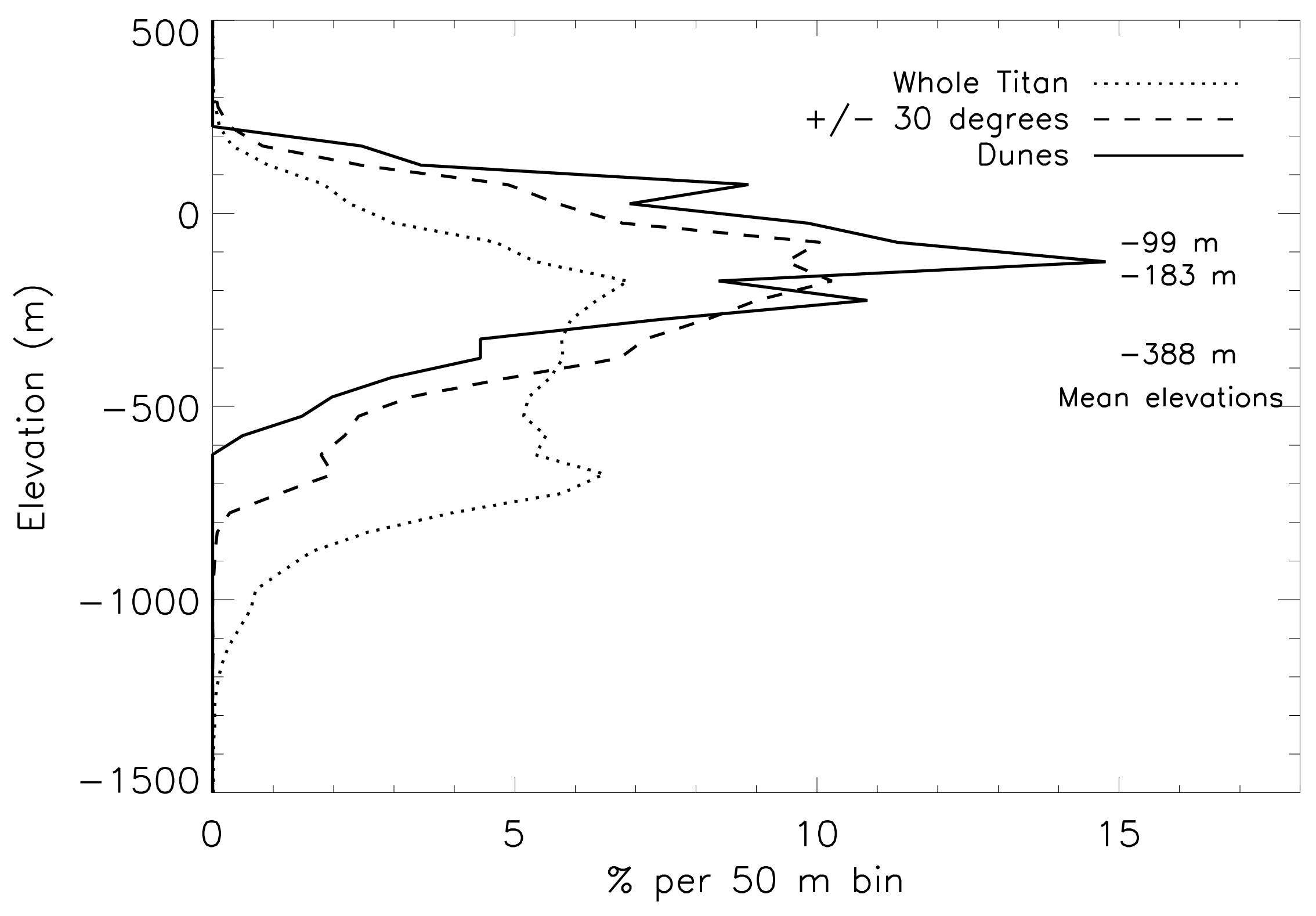
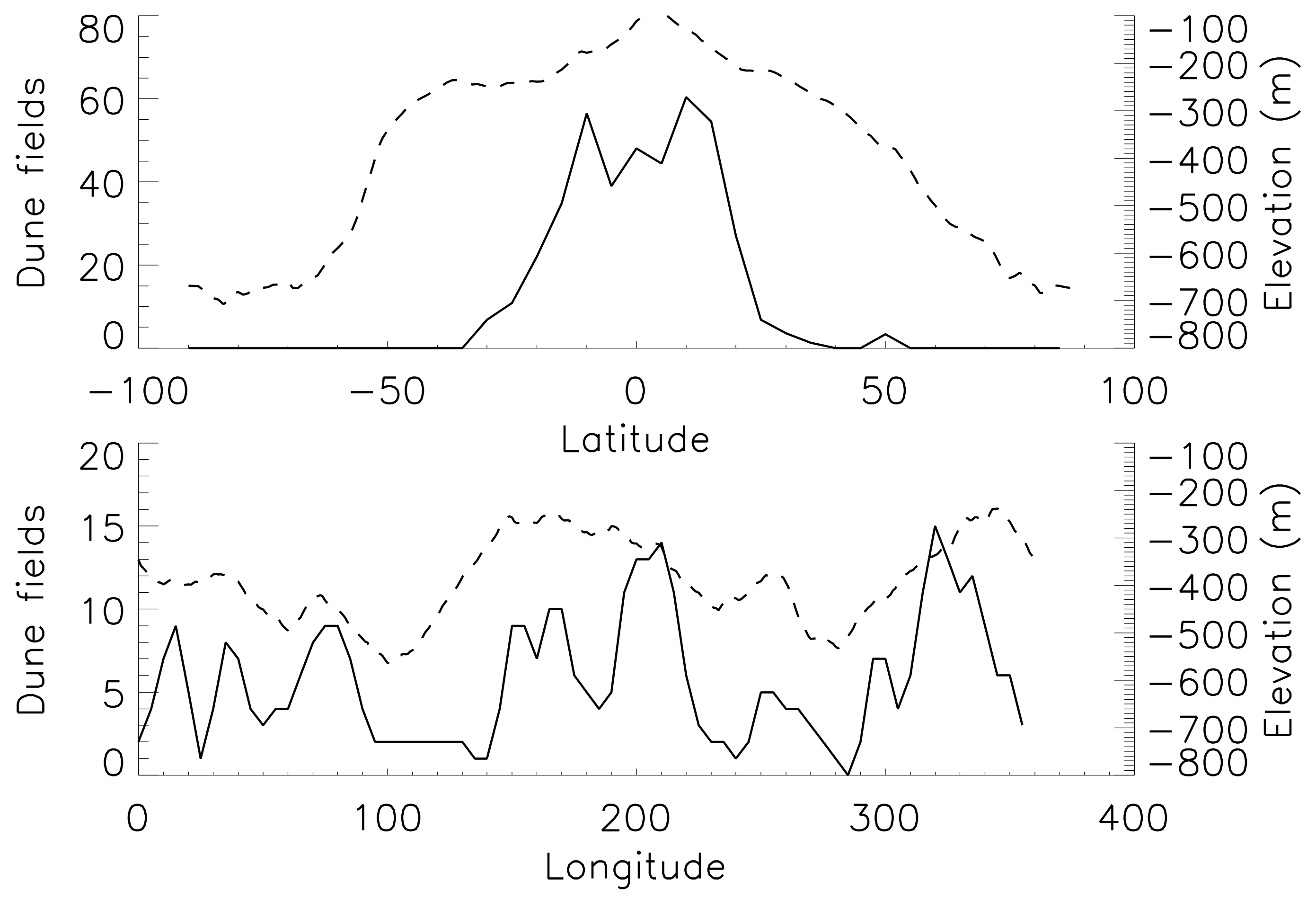

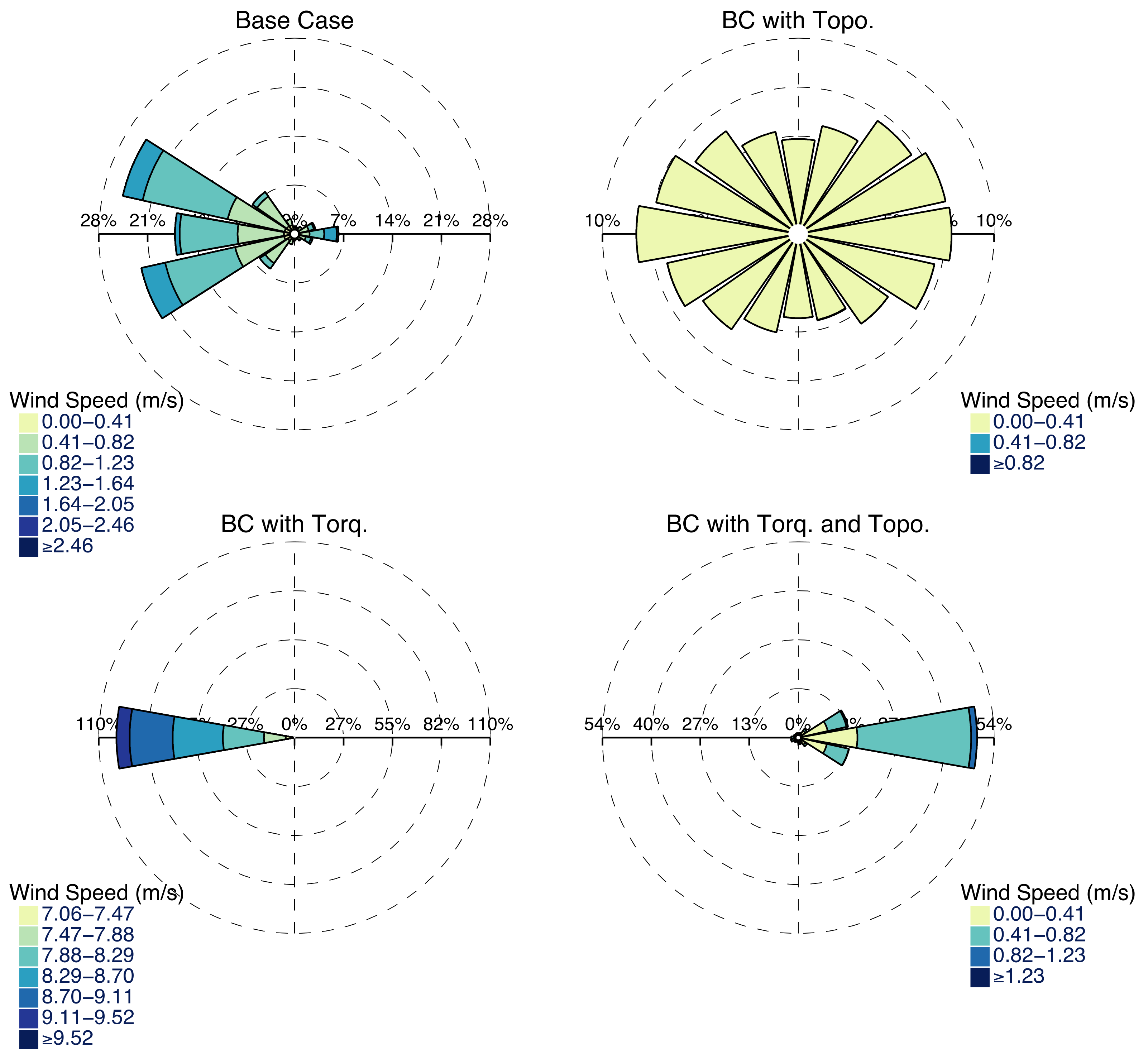
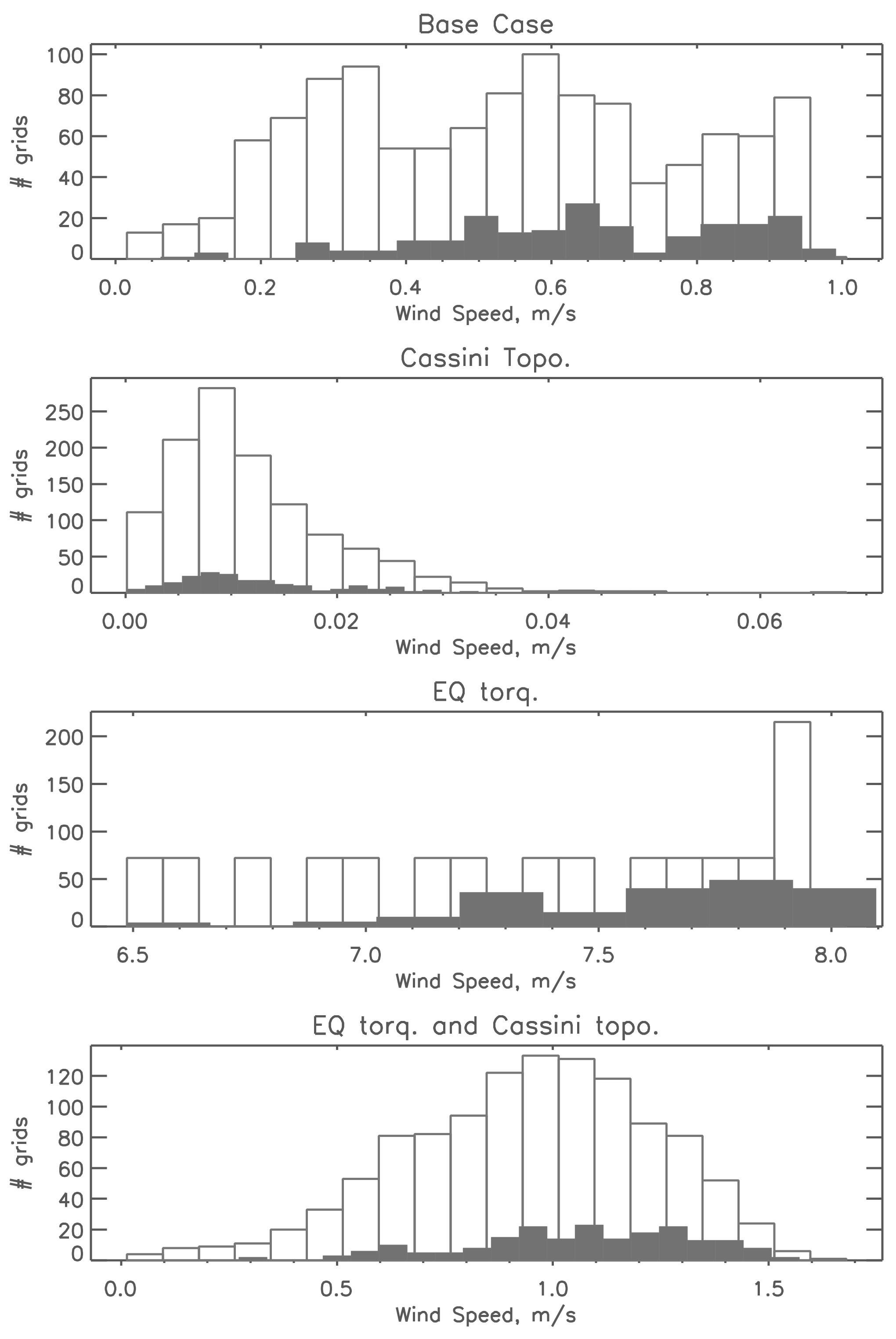
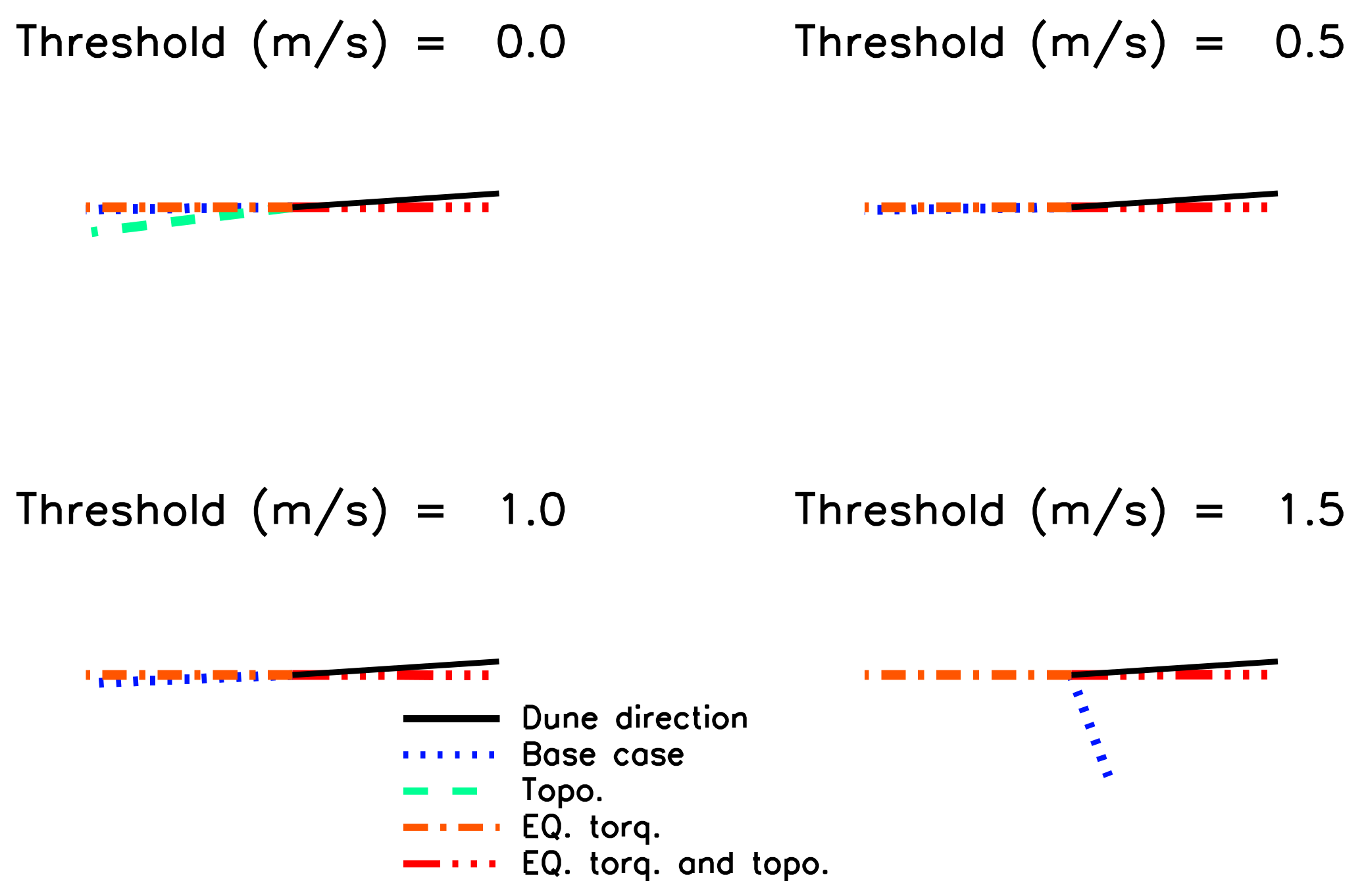
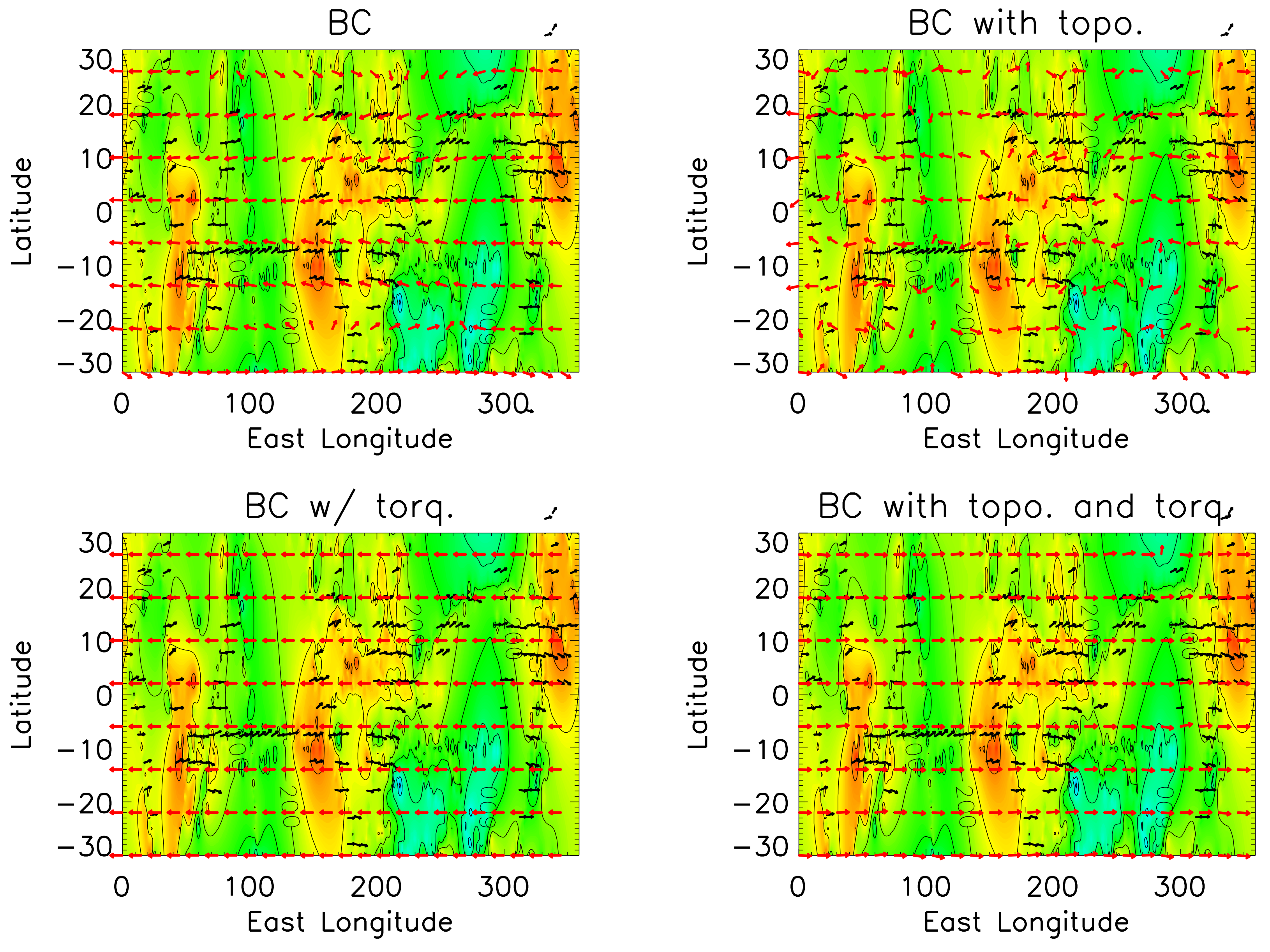
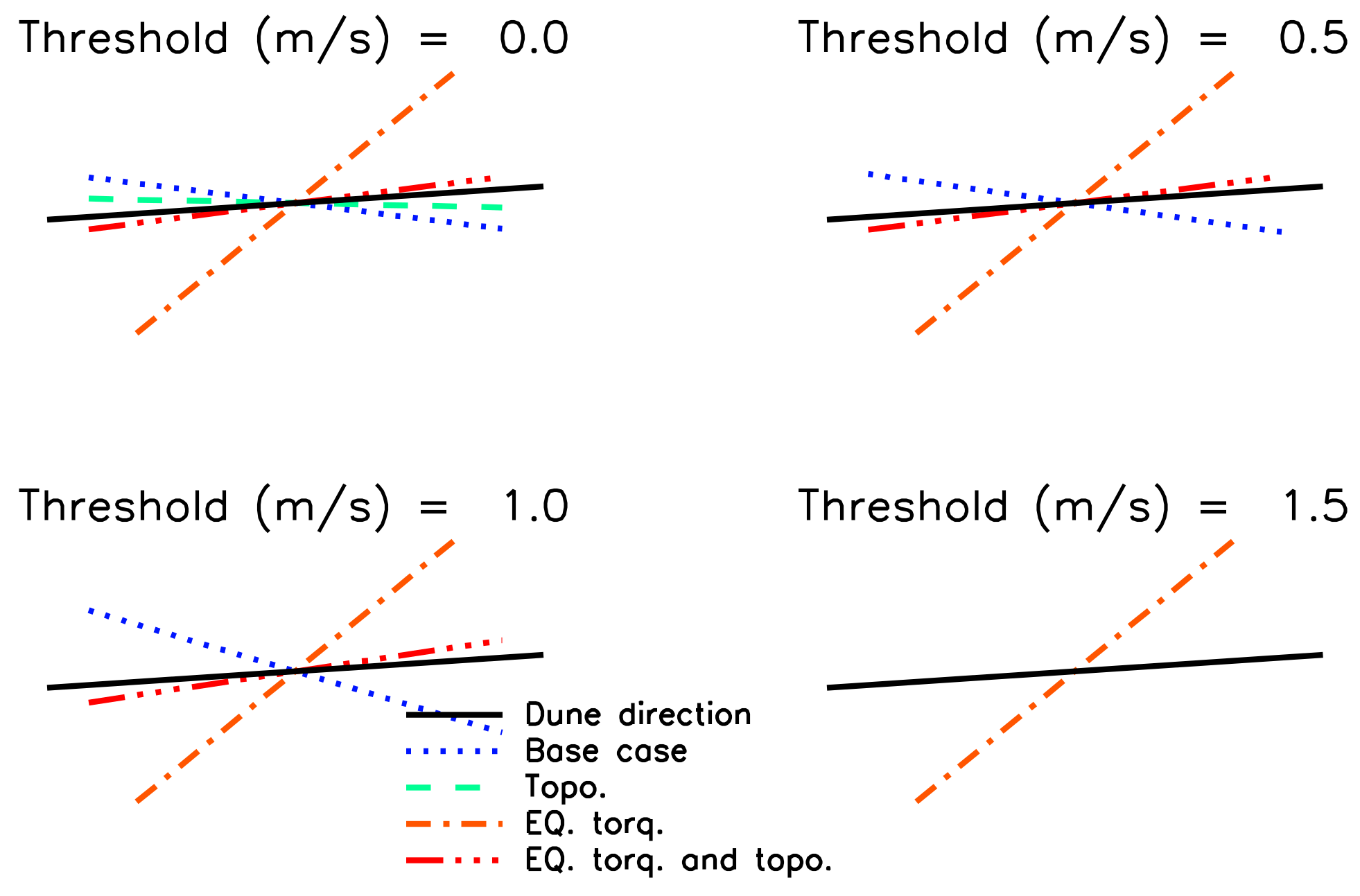
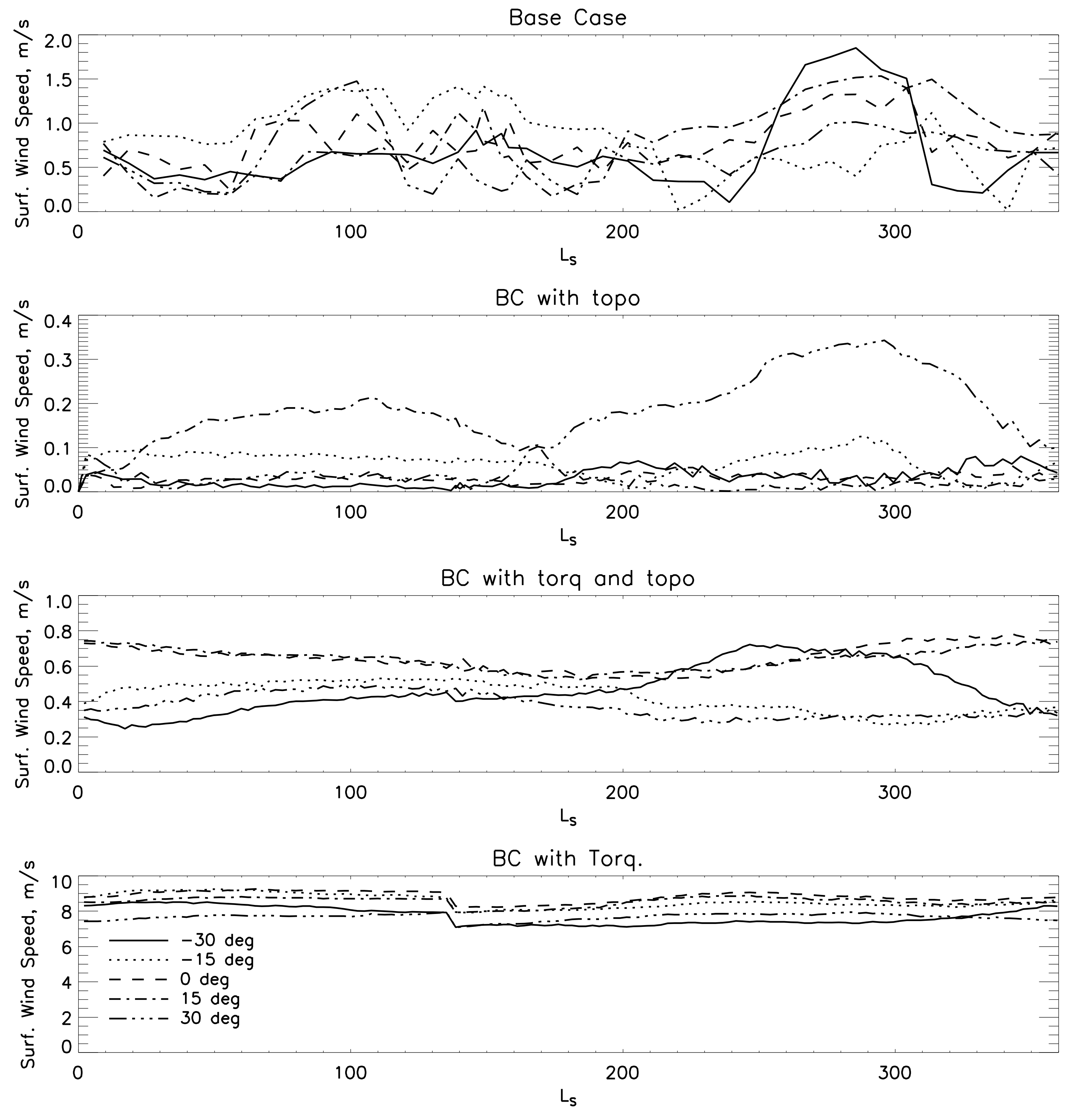
| Statistical Test | Base Case | Topography | EQ Torque | Topography and Torque |
|---|---|---|---|---|
| Wind speed and dune pres. cor. | 0.24 | 0.01 | 0.25 | 0.20 |
| RDD and dune dir. delta cos. | −0.86 | −0.24 | −0.96 | 0.95 |
© 2019 by the author. Licensee MDPI, Basel, Switzerland. This article is an open access article distributed under the terms and conditions of the Creative Commons Attribution (CC BY) license (http://creativecommons.org/licenses/by/4.0/).
Share and Cite
Larson, E.J.L. Topographic Effects on Titan’s Dune-Forming Winds. Atmosphere 2019, 10, 600. https://doi.org/10.3390/atmos10100600
Larson EJL. Topographic Effects on Titan’s Dune-Forming Winds. Atmosphere. 2019; 10(10):600. https://doi.org/10.3390/atmos10100600
Chicago/Turabian StyleLarson, Erik J. L. 2019. "Topographic Effects on Titan’s Dune-Forming Winds" Atmosphere 10, no. 10: 600. https://doi.org/10.3390/atmos10100600
APA StyleLarson, E. J. L. (2019). Topographic Effects on Titan’s Dune-Forming Winds. Atmosphere, 10(10), 600. https://doi.org/10.3390/atmos10100600





